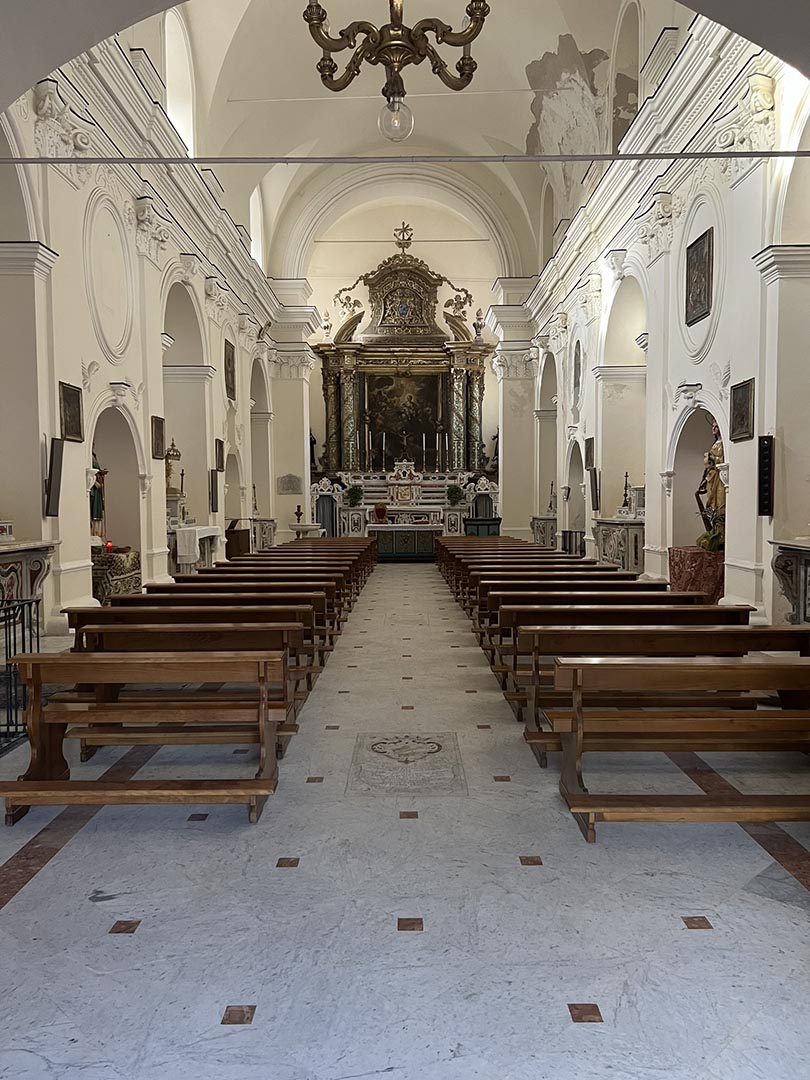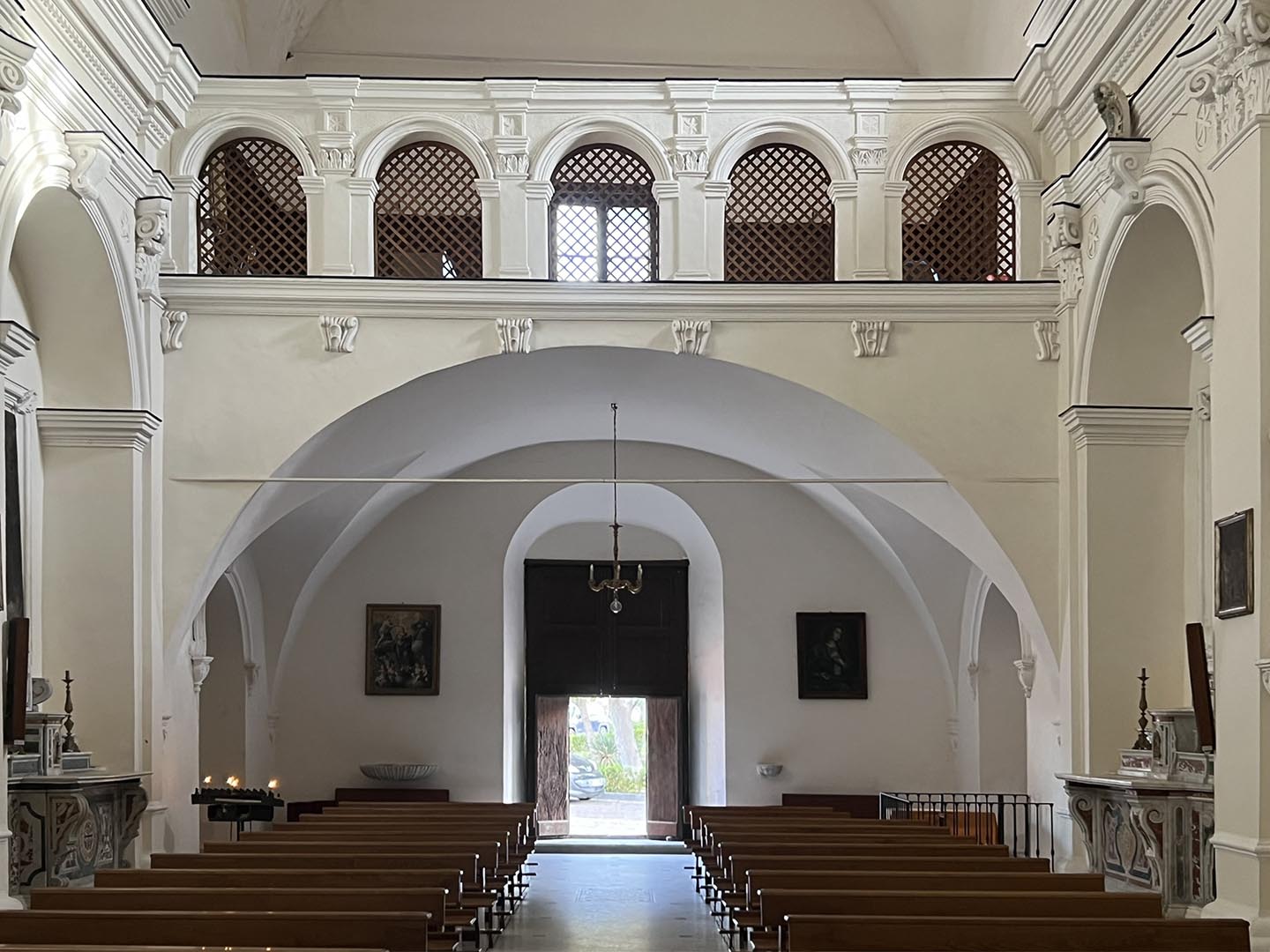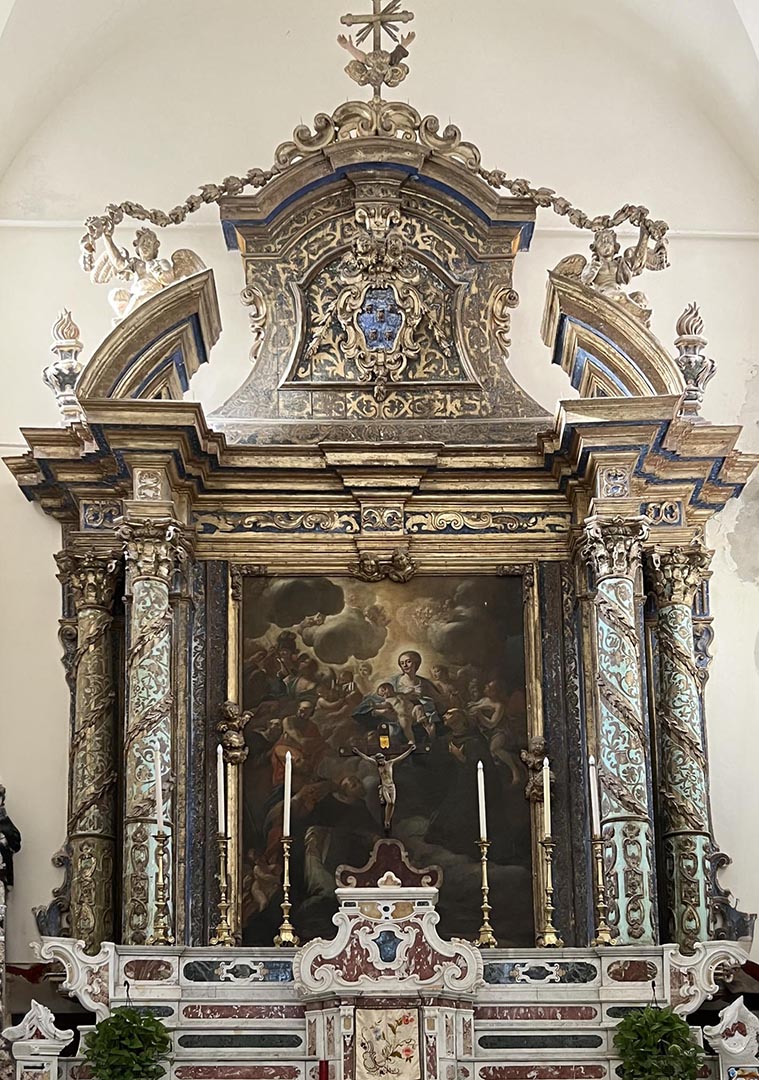 Convent
Convent
The Church of Saint Antony in Lipari
History
During the sessions of the chapter of the Capuchin provincials meeting in Randazzo in 1584 to discuss the Order's charges, the bishop of Lipari Paoloo Bellardito and a small circle of noble citizens requested the presence of the religious in the city.
Work on the building of the seat began immediately, and in 1599 the structure was completed and placed under the title of the 'Immaculate Conception of the Blessed Virgin Mary' (1st convent).
Soon the community was incited to forcibly leave the island under various pretexts, officially motivated by the search for better conditions. This was in clear contrast to the principles of the rule, which envisaged a Spartan standard of living with no economic income except public alms, while the religious devoted themselves to the small trade of local products such as sultanas, capers and many other activities linked to the agricultural world, in order to support themselves. Eventually they were forced to move away.
The events were based on the alternation in the leadership of the episcopal see of Martin Acunba ( O.Carm), Juan Pedro Gonzàlez de Mendoza ( O.E.S.A.) , Alfonso Vidal ( O.F.M.). The latter, at the insistence of some of the jurors and at the behest of the Liparoti, made a formal request to Pope Clement VII in 1600 to welcome a new community, preferring religious from his own order. The official deed of consignment of the buildings to the Observant friars of Calabria was delivered on 20 May 1600, Ascension Day.
 Convent
Convent
The Capuchin monks were soon readmitted to the island, and they were assigned an agricultural plot outside the city walls where they built a new convent aggregate under the title of the 'Assumption of the Blessed Virgin Mary' (2nd convent). Land, outbuildings and appurtenances largely turned into a town cemetery..
The structures of the Civita, today known as Villa Mazzini, were further enlarged, renovated and improved, and the work was completed around the middle of the 18th century.
A final extraordinary maintenance operation took place around 2010 and the temple was reopened on 13 June 2017.
Exterior
 The bell tower
The bell tower
The bell tower on the right has three orders: level with a pair of single blind lancet windows, 2nd level with a pair of single lancet windows, 3rd level with a single lancet window and Renaissance side ornaments.
 Church of Saint Antony
Church of Saint Antony
Interior

 Single nave, barrel vault
Single nave, barrel vault
The interior has a single nave, barrel vault, pendentives and three windows to the west. An arch separates the high altar and the presbytery area from the hall. The right and left walls are occupied by altars and niches.
The High Altar

 Two components of the high altar structure. On the left,
resting on the Tabernacle projecting onto the painting is a 17th-18th century wooden cross.
Carved and painted wood com. 102,8x64,8. On the right. The upper arch of the altar with the refined decorations.
Two components of the high altar structure. On the left,
resting on the Tabernacle projecting onto the painting is a 17th-18th century wooden cross.
Carved and painted wood com. 102,8x64,8. On the right. The upper arch of the altar with the refined decorations.
Author Unknown. First half of the 18th century approx. Carved, painted and gilded wood. The altar mensa, like the others in the church, is made of polychrome marble and is surmounted by a wooden machine consisting of columns with Corinthian capitals decorated with arabesques and phytomorphic garlands with helical development. The pairs of columns placed in convex perspective support a cornice and a broken arched tympanum. On the tops osannanti putti and acroterial vases with flames border an intermediate carved stele with a central coat of arms and festoons. The wooden aedicula contains a painting of the Virgin portrayed with St Francis of Assisi and St Dominic of Guzmán by an unknown author.
One of the two friars placed at the sides of the high altar is certainly also the more famous of the two. In fact, he is a saint and precisely Saint Paschal, a Franciscan canonised by Pope Alexander VIII in 1690. The monk saint is portrayed standing with his face turned upwards and his arms outstretched forward. The plinth is decorated with leaf motifs and bears the inscription: 'SUMPTIBUS BENEFACTORUM 1733', which attests to the year of execution. Analogies with other simulacra of the saint found in the Messina area and in various centres of southern Italy suggest that it is the work of a Neapolitan workshop. Carved, painted and gilded wood. Author unknown Neapolitan 1733
 The Virgin and Saints Francis, Dominic,
Agathon, Bartholomew, Calogero and Peter Thomas Bishop of Lipari and Patti
who died a martyr in Famagusta (Cyprus) in 1366. Giovanni Tuccari - First
half of the 18th century Technique: oil on canvas
The Virgin and Saints Francis, Dominic,
Agathon, Bartholomew, Calogero and Peter Thomas Bishop of Lipari and Patti
who died a martyr in Famagusta (Cyprus) in 1366. Giovanni Tuccari - First
half of the 18th century Technique: oil on canvas
And finally, we come to the painting attributed to Giovanni Tuccari Assimilated in the clouds and enveloped in the sunlight of divine glory and a metaphor for the 'Amicta Sole', the woman of the Apocalypse from which the iconography of the Immaculate Conception originates, Mary holds a viscous Baby Jesus in her arms, surrounded by a jubilation of angels and cherubs. To her right is a host of angels and archangels among whom Michael is recognisable; following him are: St. Bartholomew, pointing to the angel with the knife symbolising his martyrdom, St. Calogero, St. Agatho and St. Dominic, while on the opposite side St. Francis receives the Pardon of Assisi from the Virgin. At the feet of St. Dominic are two angels above a dog with a torch in its mouth. The attribution to the Messina artist Giovanni Tuccari was considered plausible for this painting, the fulcrum of the imposing carved, painted and gilded wooden altarpiece.
The altarpiece is a splendid compendium of the cult paid to the founding saints of the Franciscan order and preachers, i.e., Francis and Dominic, as well as to the saints linked to the Lipari area, Bartholomew, Calogero, Agathon and even St. Peter Thomas, Bishop of Lipari from 1354 to 1359, who died a martyr's death in Famagusta on 6 January 1355. Tuccari's intention is to exalt the triumphalist dimension of the Church against the Protestant heresies and, at the same time, is linked to the struggle waged by the Liparians against the usurping Turks. Both could only be won through faith, the intercession of the Virgin Mary, the archangel Michael and the saints to whom local devotion is linked.
Furthermore, the painting refers to an important Franciscan theme of the so-called Pardon of Assisi, the indulgence that was granted in 1216 by Pope Honorius III to all the faithful at the request of St. Francis. According to the traditional story, on a July night in 1216, while Francis was praying in the church of the Portiuncula, he had a vision of Jesus and Our Lady surrounded by a host of angels and was asked what grace he desired, having prayed so much for sinners. Francis responded by asking that complete pardon of all sins be granted to those who, having confessed and repented, visited the church. The application of the indulgence was granted for only one day of the year, 2 August; it freed from guilt and punishment in heaven and on earth, from the day of baptism to the day and hour of entry into this church.
The Choir
 Choir, second half of the 17th century, carved and painted wood approx. 250
cm x 240 cm.
Choir, second half of the 17th century, carved and painted wood approx. 250
cm x 240 cm.
It is located behind the high altar, in fact the Friars Minor Observant built the Choir above the church door and the entrance door' and the Capuchins had built it behind the "Sancta Sanctorum", i.e. behind the tabernacle.
The choir consists of a pair of stalls with four seats on each side, set against the back wall of the apse and set back from the high altar. The backs have elaborate mixtilinear cornices alternating with fluted pilasters decorated with phytomorphic motifs with acanthus leaf capitals above. The chancel is interspersed with a wooden door, possibly made earlier and allowing passage to the sacristy, marked by four cornices, three of which are decorated with leafy volutes and whorls in late Baroque style.
The Wooden Crucifix

 Crucifix, 17th-18th century, author unknown, carved and painted wood ca. 300 cm x 200 cm. Right, detail of the face of Christ
Crucifix, 17th-18th century, author unknown, carved and painted wood ca. 300 cm x 200 cm. Right, detail of the face of Christ
The sculpture depicts Christ crucified. The head is inclined, the limbs are stretched along the cross, the face is framed by a wavy beard and long hair. The loincloth, tied at the side by an obvious cord, covers the bleeding body of Christ, from whose side blood gushes copiously.
Chapels
Chapel of St Paschal Baylon

 Chapel of St Paschal Baylon. A marble altar, in the aedicula is a painting
of the Adoration of St Paschal Baylon portrayed with St Ursula and three
other figures, the work of Giovanni Tuccari made in 1741. Technique: oil on canvas
Chapel of St Paschal Baylon. A marble altar, in the aedicula is a painting
of the Adoration of St Paschal Baylon portrayed with St Ursula and three
other figures, the work of Giovanni Tuccari made in 1741. Technique: oil on canvas
Chapel of St Paschal Baylon. A marble altar, in the aedicula is a painting of the Adoration of St Paschal Baylon portrayed with St Ursula and three other figures, the work of Giovanni Tuccari made in 1741.Technique: oil on canvas
The genuflected saint is in ecstasy before the Blessed Sacrament displayed in a fine monstrance of contemporary gold work. On the left side of the canvas St. Ursula, followed by the martyr saints, is dressed in rich robes while carrying a crucifix and a flag.
The theme is the Eucharist, the centre of the spiritual life of St. Paschal of the Minims of St. Francis, canonised by Pope Alexander VIII in 1690. Although illiterate, he was able to defend Christianity and the validity of the Eucharistic sacrament against the accusations of the Protestants.
Saint Ursula, also a defender of Christianity and a legendary martyr of the Middle Ages, lost her life by arrows in the German city of Cologne together with her companions. The complexity of the subject matter suggests that the painter had to follow the instructions of his client, Bishop Bernardo Beamonte, who ruled the diocese of Lipari from 1733 to 1742 (Iacolino, 1994, p. 225).
The representation of the host in post-Council of Trent art began to become more and more frequent; sometimes it is found inside a monstrance in the shape of the sun, in front of which angels and saints prostrate themselves, such as Saint Paschal Baylòn, who sees it in the sky falling in ecstasy. Only after the great religious struggles, therefore, did the Eucharist, in the form of bread or the host, become part of the artistic iconography to which this painting bears witness.
Chapel of the Assumption with St. Benedict and St. Gertrude of Helfta

 Author: Messina area - around 1753 - 1769. Title: The Immaculate Conception
with Saint Benedict and Saint Gertrude of Helfta. Technique: Oil on canvas.
Inscription: IN CORDE GERTRVDIS INVENIETIS ME
Author: Messina area - around 1753 - 1769. Title: The Immaculate Conception
with Saint Benedict and Saint Gertrude of Helfta. Technique: Oil on canvas.
Inscription: IN CORDE GERTRVDIS INVENIETIS ME
Autore: ambito messinese - 1753 - 1769 circa. Titolo: L'Immacolata con San Benedetto e Santa Gertrude di Helfta. Tecnica: olio su tela. Iscrizioni: IN CORDE GERTRVDIS INVENIETIS ME
The Immaculata is seated on the clouds with her face turned towards heaven, while the bust makes a slight torsion to the right with joined hands, in contrast to the flexed left leg. The feet are resting on a half-moon, according to the Johannine vision, while at the same time crushing the serpent. On the left side of the canvas angels hold the cope, mitre and crosier of Saint Benedict in prayer. On the opposite side is Saint Gertrude, holding her own heart inhabited by the Child Jesus. A putto at the bottom holds two lilies, an attribute linked to the Immaculate Conception as a symbol of purity, while two others at the top hold the scroll on which is written: IN CORDE GERTRVDIS INVENIETIS ME.
St Gertrude popularised the cult linked to the humanity of Christ, translated into the popular image of the Sacred Heart. In order to reach out to men, she wrote countless letters, becoming the forerunner of St. Teresa of Avila and Margaret Mary Alacoque, and her canonisation took place in 1738.
The painting is placed above the altar with the coat of arms of Bishop Vincenzo Maria de Francisco, of the Order of the Friars Preachers (1753 - 1769), who may have commissioned it (Iacolino, 1994, p. 225).
Chapel of St. Teresa of Avila.


The iconography refers to two distinct episodes: the first, which occurred around 1560, concerns the celebrated vision of the angel thrusting the fiery dart into St. Teresa's heart, the same episode that inspired one of the most beautiful and shocking sculptures of Bernini's career. The second relates to the vision of 15 November 1572, when Teresa received the grace of 'spiritual marriage': 'He appeared to me then through an imaginary vision, as on other occasions, in the innermost recesses of my soul, and, holding out his right hand to me, he said: Look at this nail: it is the sign that from today onwards you will be my bride. Until this moment you have not deserved it; from now on you will take care of my honour, not only because I am your Creator, your King and your God, but also because you are my true bride: my honour is now yours, and yours mine'.
The scene is depicted here as multicoloured angels hold up the cross of Jesus who, unclasping his right hand, hands the nail to St. Theresa. Behind the mystic's back flies the dove of the Holy Spirit while an angel is about to encircle her forehead with a crown. One of the cherubs at the bottom pierces the heart Teresa is holding with the flaming dart and another holds the book where the Saint's motto can be read: AUT PATI AUT MORI.
The iconographic theme of ecstatic rapture is closely connected to the process of figurative renewal that affected art in the aftermath of the Council of Trent. The intention of this type of work was to exalt the closeness of the saints with the divine, especially when they receive visions, are in ecstasy, in prayer, while listening to the music of angels, in order to appeal to the public and involve them as emotionally as possible. In addition, it must be said that St. Teresa is one of the saints most represented in art, in fact, her canonisation in Rome was one of the most solemn in the history of Christianity. The celebration took place on 12 March 1622 together with those of Saints Ignatius of Loyola, Francis Xavier, St Isidore and St Philip Neri.
Giovanni Tuccari, the author of the painting, was recognised among Messina painters as being poetically imaginative, capable of rendering the work with excellent colouring and natural drawing. One can appreciate the figures rendered with boldness through the variation of hues and the strength of chiaroscuro. Together with these characteristics, one can observe here the strong realism of the objects, rendered with abundance of detail.
Little is known about Tuccari's training, apart from the fact that his father and brother were painters, and it is therefore likely that, after a brief apprenticeship in his homeland, he followed in the footsteps of many other artists by going to study in Naples and Rome.
The cult of the Spanish mystic was probably introduced to the island around 1585-1593 by Bishop Martino D'Acugna, a Discalced Carmelite, a confrere of Saint Teresa of Avila and Saint John of the Cross (G.Iacolino, Le Isole Eolie nel risveglio delle memorie sopìte . Dalla battaglia di Lipari del 1339 alla vigilia della 'Ruina' del 1544, 2015, p. 18). The altar dedicated to St. Teresa bears the coat of arms of bishop Bernardo Beamonte (1733-1742), also a Discalced Carmelite, who trained in the convent of Santa Teresa in Palermo and probably commissioned Tuccari's canvases (G. Iacolino, Le Isole Eolie nel risveglio delle memorie sopite. The First Christian Millennium. 1994, p. 225).
Notes
Many of the images and information are taken from Wikipedia, Chiesa di Sant'Antonio in Lipari.
Other images and information are taken from two dissertations by Dr Melissa Prota.
University of Messina- Faculty of Arts and Philosophy. Degree course in cultural heritage operator. 'For a widespread museum: wooden sculpture in the churches of Lipari'. Academic Year 2011- 2012
University of Palermo. School of Human Sciences and Cultural Heritage. Department of Culture and Society. Master's Degree Course in History of Art. 'Sacred painting in Lipari from the 16th to the 18th century'.